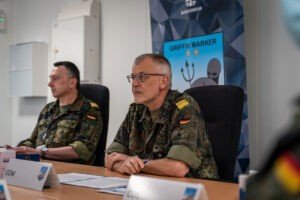The establishment of a maritime command centre is progressing. Deu Marfor is well on the way to achieving full operational capability.
Deu Marfor, the German Maritime Forces Staff, is ready. Commissioned on 23 January 2019, the staff is now capable of planning, supporting and conducting multinational maritime manoeuvres and operations. The goal of taking on more responsibility within NATO resulted from the security situation following the Russian annexation of Crimea in 2014. The interim goals achieved to date and the experience gained show one thing above all: Deu Marfor has proven its planning and leadership capabilities.
Exercise Northern Coasts 2019 (Noco 19) gave Deu Marfor the opportunity to conduct a major maritime manoeuvre soon after it was set up. The focus was on tactical cooperation with alliance partners and testing the basic structure established up to that point. In the so-called Peacetime Establishment, the staff has around 90 soldiers, with 25 posts earmarked for multinational exchange and liaison officers. As Commander Task Force, the Deputy Commander Deu Marfor, Flotilla Admiral Stephan Haisch, and his staff led three subordinate task groups with over 3,000 soldiers from 18 participating nations. During implementation, the expertise gained over many years from the task forces disbanded in 2018, which had previously supported exercises of this magnitude, was used to a large extent. Most of the post holders were transferred to the new Deu Marfor command staff so that their knowledge and experience were retained.
Noco 19 has shown that the Deu Marfor core staff has the necessary expertise for cold-start capability and is able to perform leadership tasks at task force or one-star level on an ad hoc basis without further personnel support. This capability has been retained to this day and is the basis for the concept of surviving at the next higher management level.

The commander of Deu Marfor, Rear Admiral Jürgen zur Mühlen (right) with his deputy, Flotilla Admiral Stephan Haisch, Photo: Bw
For example, in order to serve NATO as a maritime headquarters at the level of a Maritime Component Command (MCC), also known in this context as a High Readiness Forces Maritime Headquarters or HRF (M) HQ for short, Deu Marfor must undergo certification in accordance with NATO standards. The major challenge here lies in the extensive tasks of the entire spectrum of maritime capabilities. In order to fulfil this requirement, the core staff must almost double in number during an activation and depending on the type and size of the operation. The additional personnel are generated from experts in all relevant fields of naval warfare, among other things, but joint and cross-force expertise must also be covered. For example, capabilities from the medical service, cyberspace and geoinformation are part of the increase, as well as liaison officers from the army and air force and special forces. Deu Marfor has its focus in the maritime sector, but works closely with the other players. This ability to think and act as a joint force must be established and maintained. This is precisely where the dividing line runs from what is already known to the claim to leadership that the German Navy is now striving for and which it will face in the future with Deu Marfor.

The logo of Deu Marfor. The feather and the trident in the griffin's clutches represent naval warfare and the planning work of the staff
In May 2022, Deu Marfor carried out the Griffin Marker exercise supported by computer simulation in preparation for future certification. After a preliminary planning phase, the staff practised for a fortnight in a crisis scenario developed by NATO. In this scenario, Deu Marfor was embedded in the NATO command structure in the role of an MCC and was responsible for the planning and execution of maritime operations. During the exercise, 8,200 fictitious soldiers were in command, spread across around 60 ships, 80 aircraft and helicopters as well as amphibious units. These in turn were subdivided into three task forces.
In terms of numbers, this exceeded Noco 19 by a factor of three. This is where the scope of Deu Marfor's new role becomes clear, which clearly distinguishes the command staff from the tasks of former task forces.
The processes running at this level are multi-layered and complex. The biggest challenge was the considerable amount of information that had to be analysed, evaluated and ultimately implemented in the planning and management process. From this point of view, internal communication between the individual areas of the staff, the branches, was particularly important. However, it was also necessary to coordinate with external bodies such as the Joint Forces Command, the Joint Logistic Support Group and, above all, with the headquarters of the land and air forces. This is ensured by a strict sequence of briefings, meetings and working groups, known as the battle rhythm.
In addition to overcoming these challenges, other successes were also achieved. Griffin Marker has moulded Deu Marfor and allowed it to grow into a high-performance team. In doing so, it has proven its worth to already be working with the structures and work processes of an HRF (M) HQ that are generally applicable in NATO. Multinational officers from other Marfors and headquarters were quickly integrated into the staff and rapidly incorporated into the necessary work processes. Communication with superiors and subordinate areas was also easy for those involved, as English is the daily working language.

As a multinational organisation, Deu Marfor thrives on exchanges with allied nations
Based on the results achieved, the Initial Operational Capability (IOC) of Deu Marfor as HRF (M) HQ was notified to NATO. This was also the starting signal for preparations for the 2023 and 2024 exercise phases, after which the staff's Full Operational Capability (FOC) is to be declared. Embarked on board a command and control platform, Deu Marfor will have to demonstrate its ability to conduct a real exercise with real ships, boats, helicopters and aircraft.
The decision to focus more strongly on alliance defence again with a maritime headquarters was reaffirmed with Russia's war of aggression against Ukraine, which began in February 2022. This was reflected in the great interest shown by all allied Baltic Sea nations during Griffin Marker, all of whom took part in the exercise with personnel. In order to meet the resulting challenges and expectations, Deu Marfor must continue to rely on the knowledge and commitment of the entire German Navy and many other branches of the Bundeswehr as well as international support. With the experience gained to date, Deu Marfor will achieve Full Operational Capability 2025 and be able to respond flexibly to the changes taking place within NATO and in Germany.
Lieutenant Commander Maximilian Bellini is an officer in the N3 Branch Deu Marfor. Oberleutnant zur See Florian Ruchnewitz is Logistics Liasion Officer in the N4 Branch Deu Marfor and also works in the area of information work.
Maximilian Bellini and Florian Ruchnewitz












0 Kommentare